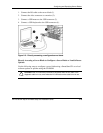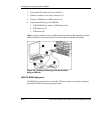
Configuring and Deploying Server Blades
HP ProLiant BL40p Server Blade Setup and Installation Guide 2-13
HP CONFIDENTIAL
Writer: Amy Clute File Name: c-ch2 Configuring and Deploying Server Blades.doc
Codename: Black Ice Part Number: 307153-002 Last Saved On: 12/17/03 2:04 PM
NOTE: For more information about these hardware and cabling configurations, refer to the H
P
ProLiant BL p-Class System Hardware Configuration and Installation Poster and the
documentation that ships with the diagnostic station.
Creating the Boot Diskette
The SmartStart Scripting Toolkit provides the tools and information for creating a
diskette that will configure the hardware and install the operating system.
For details, download the latest version of the “SmartStart Scripting Toolkit” from
www.hp.com/servers/sstoolkit
and refer to the SmartStart Scripting Toolkit User Guide.
It is also possible to configure the hardware manually using RBSU through the iLO
remote console. With this method, the diskette would be more generic and would
integrate into the existing network OS installation process. Refer to the “Integrated
Lights-Out Management” section in this chapter.
For the most current information about operating system support on server blades,
refer to the operating system support matrix available at:
www.hp.com/products/servers/platforms
then navigate to the OS support for ProLiant BL p-Class server blades.
IMPORTANT: The ProLiant BL40p server blade has the ability to connect to a SAN using
PCI-X expansion boards. You can preconfigure the SAN HBA driver Smart Components in the
ProLiant Support Pack. Refer to the HP ProLiant Support Pack and Deployment Utility User
Guide or “SAN Support” in this chapter for more information.
USB Diskette Drive Deployment using PXE
PXE enables server blades to load an image over the network from a PXE server then
execute it in memory. The first NIC on the server blade is the default PXE boot NIC,
but any of the other NICs can be configured to boot PXE. Refer to “PXE
Deployment” in this chapter for more information.


















